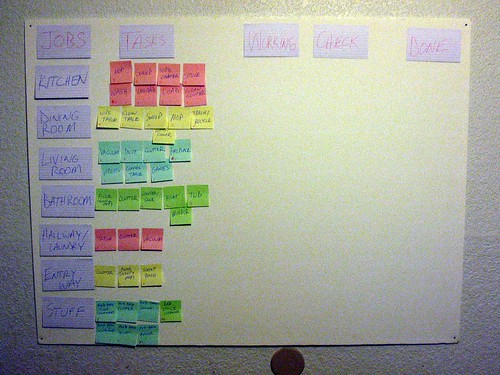Here's how he did it:
Materials
- Foam board nailed to the wall in the dining room.
- Self stick 3x5 index cards
- Small sticky notes
- Mom = Product Owner
- Dad = ScrumMaster
- Kids = Scrum Team
- Mom created spreadsheet with the "sprint backlog" a few days before. -- Jobs (or areas of the house) divided into smaller tasks.
- Dad created the heading cards, job cards and the sticky notes of each task.
- Around 10:30 AM the whole family held a stand up meeting is held in front of the board.
- Points were assigned to each task. Just three possible values to keep it easy: 1 = easy, 2 = normal, 3 = hard. Point values of each task were decided jointly by the kids, but Mom & Dad had a veto power. The point values were written on lower right of each task sticky note.
- Go!
- The kids pick a task or two, writing their initial in lower right corner of each task sticky note and moving sticky note to the "Working" column in the Job row.
- When a kid completes a task, s/he moves the sticky note to "Check" column. The did then selects next task by initialing and moving it's sticky note to the "Working" column.
- Mom or Dad checks the quality of the work, moving the sticky back to "Working" or over to "Done" column.
- Proceed until all tasks complete about two hours later!
Thank you, Alan for the article and permission to print it.
Do you use a taskboard or sprint planning to organize your family tasks? Please let me know how you did it, preferably with a picture!

